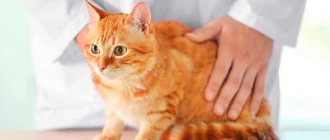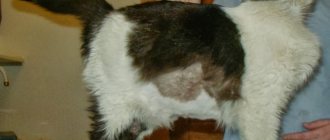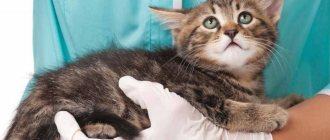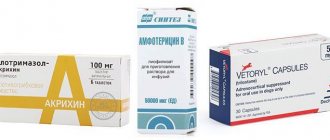Do cats get stomatitis? Without a doubt - yes! Inflammatory processes in the oral cavity are quite common in cats. Unlike humans, pathogenic microflora is common on the mucous membranes of the oral cavity.
At the slightest mechanical damage, pathogenic microorganisms enter the wound and inflammation begins. At the site of inflammation, ulcers appear, which easily turn into stomatitis.
Stomatitis affects the cheeks, tongue, and gums of the animal and brings terrible discomfort to it. In this article we will talk about the symptoms and treatment of stomatitis in cats.
Start
The initial stage of development of stomatitis is considered to be the catarrhal stage . It manifests itself in the form of inflammation of the oral cavity and the appearance of shallow ulcers. If you start treating catarrhal stomatitis in time, the infection process will not go further.
A more advanced version of the catarrhal stage is acute ulcerative stomatitis . The symptoms of this stage are immediately noticeable - the animal’s tongue and gums become covered with festering ulcers and granulations, causing a lot of trouble. The cat will have difficulty swallowing, salvation (excessive salivation) will continue, and he will breathe with foam at his open mouth.
Eating with such wounds is impossible, but the cat will be very thirsty, since the mucous membranes will become very dry. This is made worse by the fact that the cat will temporarily lose its ability to wash itself. The animal's breath will begin to smell unpleasant (“as if someone had died there”) and the temperature will rise.
Granulations (white small ulcers in large numbers) may indicate such serious diseases as feline distemper, acute infections and damage to the pharynx. Antibiotics are required to treat them.
Types of stomatitis
In veterinary medicine, several subtypes of stomatitis are distinguished depending on the nature, cause of occurrence, location of lesions and the clinical picture of inflammation.
Classification by location
Depending on the area of localization, stomatitis is divided into:
- Gingivostomatitis. It is characterized by a gradual spread of the lesion. The mucous membranes of the entire mouth and gums become inflamed.
- Glossitis. The focus of localization is the tongue.
- Faucite. Inflammation of the palatoglossal arch.
- Palatinite. The focus of the lesion is the palate.
- Gingivitis. Inflammatory phenomena are localized on the gums.
- Cheilitis. The focus of localization is the lips.
Classification according to the nature of inflammation
According to the severity and nature of the inflammatory processes, stomatitis can be:
- Alternative. At the site of inflammation, tissue destruction processes predominate.
- ulcerative Characterized by the appearance of weeping ulcers on the mucous membranes of the oral cavity;
- necrotic. Complication of ulcerative. Characterized by tissue death.
- Exudative. It is characterized by redness of the mucous membranes and the release of fluid (exudate) from small blood vessels.
- catarrhal The most common form of pathology. Inflammation is manifested by redness and soreness of the gums, swelling, an unpleasant odor from the animal’s mouth, and excessive salivation;
- serous. There is a white or yellowish coating in the animal’s mouth;
- purulent. Abscesses, boils, fistulas, and carbuncles form in the oral cavity. Pus is released;
- gangrenous (putrefactive). Develops as a complication of ulcerative disease. Characterized by a fetid odor;
- fibrinous. White exudate has a protein structure;
- hemorrhagic. The secreted liquid has a reddish color.
- Proliferative (productive). In the area of inflammation, active cell proliferation occurs, which leads to the proliferation of connective tissues. This type of stomatitis is extremely rare.
In veterinary medicine, mixed types of inflammation of the exudative type are distinguished: catarrhal-purulent, serous-fibrinous, purulent-fibrinous, serous-purulent, purulent-hemorrhagic.
Classification by origin
Depending on the cause of occurrence, there are:
- Primary. Appears as a result of the action of the cause of the pathology on the oral mucosa.
- traumatic;
- chemical;
- thermal.
- Secondary. Develops as a complication of other diseases.
- papillomatous (viral);
- fungal;
- infectious;
- hormone;
- endocrine;
- uremic;
- food, allergic;
- autoimmune.
Classification according to the course of the disease
According to the course of the disease, stomatitis can be acute (up to 2 weeks), subacute (from 2 to 6 weeks), chronic (over 6 weeks). Acute and subacute forms are characterized by a pronounced clinical picture. A chronic disease has a vague clinical picture and provokes the appearance of a general malaise in the animal.
Advanced stage
Gangrenous stomatitis is an advanced, most severe stage of the disease.
What are her symptoms?
- On the mucous tissues, tongue and cheeks of the cat, “traces of destruction” will be noticeable - ulcers and severe ulcers;
- Increased salivation and lack of appetite;
- Specific odor from the mouth;
- Enlarged lymph nodes;
- General pain and lethargy of the animal.
If decisive measures are not taken quickly to treat gangrenous stomatitis, tissue amputation may become necessary. Also, sometimes phlegmonous stomatitis is isolated, which consists in the spreading of pus under the mucous membrane, which is, in a way, the beginning of the end.
IMPORTANT: Some breeds are predisposed to such diseases: British, Scottish, Maine Coons and Sphynxes.
Symptoms of the disease
Cat owners should know the main symptoms of the disease, which can be used to suspect this oral disease in their animal. Each type of stomatitis has its own characteristic signs; we list the main ones.
10 signs of stomatitis
- The cat washes itself frequently and rubs its mouth vigorously as if something is bothering it.
- Increased salivation appears.
- The animal is thirsty. The cat drinks all the time.
- Appetite drops. The pet refuses its favorite treats.
- The lymph nodes in the lower jaw are enlarged.
- An unpleasant odor appears from the oral cavity.
- Hyperthermia. Body temperature rises.
- The cat sleeps a lot, becomes lethargic, and refuses active games.
- Saliva turns pink.
- Pus is released. Ulcers form in the mouth.
Important!
If you find signs of pathology in your pet, you must immediately show the animal to a specialist who knows what stomatitis looks like in a cat.
Causes of ulcerative and gangrenous stomatitis
Primary stomatitis is the simplest form of the disease. It usually occurs as a result of everyday “troubles”: food that is too cold or hot, hard pieces of food that have scratched delicate skin, chemical burns and even your own microflora (which are out of balance and corrode existing wounds).
There are known cases of stomatitis occurring as a reaction to cat shampoo - when bathing it was not washed off completely, and the cat, while licking itself, was poisoned and burned the mucous tissue. If primary stomatitis is not cured, it goes into a more acute phase.
Secondary stomatitis occurs against the background or as a consequence of other, more serious diseases. These are: severe forms of infectious diseases, stomach diseases, diabetes mellitus, vitamin deficiency, leukemia, etc.
Strengthening your pet's immunity
Recurrent stomatitis in cats in most cases is the result of a weakened immune system that cannot cope with infectious agents.
To increase the body's defenses, you can use immunostimulating agents. They are selected by a veterinarian. Among the common drugs, Catonazal and Gamavit have proven themselves well.
The state of immunity is greatly influenced by the nature of nutrition. Sometimes stomatitis in cats is one of the symptoms of an allergy to ready-made food. Premium products are the safest for pets' health. But not all owners can afford to purchase expensive feed. In this case, it is better to give preference to natural products. It is beneficial for cats to eat slimy porridges and soups, cottage cheese, and cereals. You can add a small amount of boiled minced meat to prepared dishes.
What to do if your cat has stomatitis?
If you notice at least one of the symptoms listed above, contact your veterinarian. He will examine your pet and prescribe the necessary tests and treatment for ulcerative stomatitis. Before that, you need to change the animal’s diet - he cannot chew, and it hurts to swallow. Therefore, remove everything hard, spicy, hot and cold from the menu, let everything be warm and creamy.
Afterwards, you need to disinfect: take a 3% chlorhexidine solution or a 1% soda solution and rinse your mouth with it. This procedure should be done several times a day, after each meal. If you have Lugol in your medicine cabinet, then you can start smearing wounds by mixing it with glycerin. If necessary (and it will most likely appear), give your cat antiviral agents and a complex of vitamins to maintain his immunity.
What to do at home
The owner must strictly follow the veterinarian's instructions. It is prohibited to prescribe medications yourself, increase or decrease their dosage! Some pet owners prefer not to go to a veterinary clinic and treat their pets with folk remedies.
It is not forbidden to use decoctions of medicinal herbs (sage, chamomile, oak bark, etc.), but they should be used as an addition to traditional treatment.
A disease as serious as stomatitis requires adjustments in diet. The diet should be enriched with nutrients and consist of liquid and semi-liquid foods. Chicken and beef broths, pureed soups, and pureed porridges are ideal.
It should be taken into account that a weakened cat, experiencing pain and discomfort when eating, will refuse to eat.
In this case, you should force feed, introducing food into your mouth using a syringe. You need to act carefully so that the animal does not choke.
How to treat ulcerative stomatitis in cats?
For mild forms of stomatitis, medications such as Lugol and Traumeel are usually prescribed. It is effective to wash wounds with herbal decoctions (chamomile and calendula), which simultaneously has an antibacterial and healing effect.
To treat the second stage, ulcerative stomatitis, herbs are indispensable. At the same time, the doctor prescribes strong medications and antibiotics. The third, most severe stage of stomatitis often requires surgical intervention. During this period, the cat may be admitted to the hospital for full treatment.
It often happens that the disease has a bad effect on dental health, or it is a consequence of this. There is a need to go to the dentist in order to cure tartar or caries, and only after that continue treatment.
Veterinary assistance from a specialist
First of all, the type of stomatitis and the cause of its occurrence are determined, and the concomitant disease that caused the inflammation is determined.
For example, with the papillomatous type of the disease, surgical removal of papillomas and the prescription of immunostimulating, antiviral drugs will be required. Autoimmune feline stomatitis requires the removal of all of the cat's teeth. Moreover, more than 2 units are not removed at one time.
Thus, veterinary care for stomatitis in cats is entirely based on correct diagnosis.
Prevention of stomatitis in cats
- Oral and dental hygiene is the main cause of stomatitis. Brush your pet's teeth regularly, thereby stopping the proliferation of pathogenic bacteria;
- Review your animal's diet, focusing on high protein and calcium content. It must be balanced so that the cat receives all the necessary vitamins and microelements;
- Once every six months, conduct a routine medical examination of the whole body, and visit the veterinarian every 3 months. This will make it possible to identify any diseases at the initial stage, which will protect the cat from secondary stomatitis;
- Get all the necessary vaccines and carry out timely treatment for worms and parasites.
IMPORTANT: Do not forget about your own safety.
It is necessary to limit your pet’s interaction with household members, especially children. Provide him peace and comfort. After each contact with a sick animal, wash your hands with soap.
Prevention and oral care rules
How to prevent the appearance of a gangrenous form of the disease:
- Don't give your cat bones.
- Keep chlorine-containing cleaning products away from your pet's food.
- Brush your cat's teeth 2 times a week using a special brush designed for pets.
- Do not give your pet hot food.
- Balance your cat's diet by including vitamins and minerals. Do not feed your pet junk food.
- Periodically inspect your pet's mouth for redness and caries.
- Do not engage in self-therapy if your cat shows signs of stomatitis.
To prevent stomatitis, it is recommended to brush your cat’s teeth 2 times a week.
To prevent stomatitis in our little brothers, it is important to promptly eliminate chronic foci of infection in the animal’s body. Otherwise, the cat’s immune system will gradually become depleted and problems with the oral mucosa will appear.
Prevention
To avoid such dire consequences, it is necessary to perform many hygiene tasks and more.
- Firstly, every pet owner should monitor the cat’s oral cavity. Brush your pet's teeth, don't think that this is a very disgusting activity. But you don't need to use a regular toothbrush. This brush will not work for them. It is worth buying a special or children's brush. These can be purchased in special stores. Don't neglect this activity!
Don't forget to brush your teeth - Secondly, pay attention to the cat's cheeks and tongue. Carefully inspect the entire oral cavity. If you notice something wrong, immediately go to the nearest veterinarian.
- Try not to let your animal out of sight, because it can join the company of sick animals, where it will definitely pick up something. Vaccination can also be a good protection.
- When keeping two or more pets, two conditions must be met: protect the sick pet from others, and also resort to hygiene products yourself after contact.
- At the first manifestation of any symptom, you must immediately provide “first aid” (this was discussed earlier) and go to the doctor.
Watch also the video on the topic:











